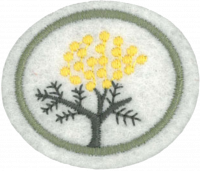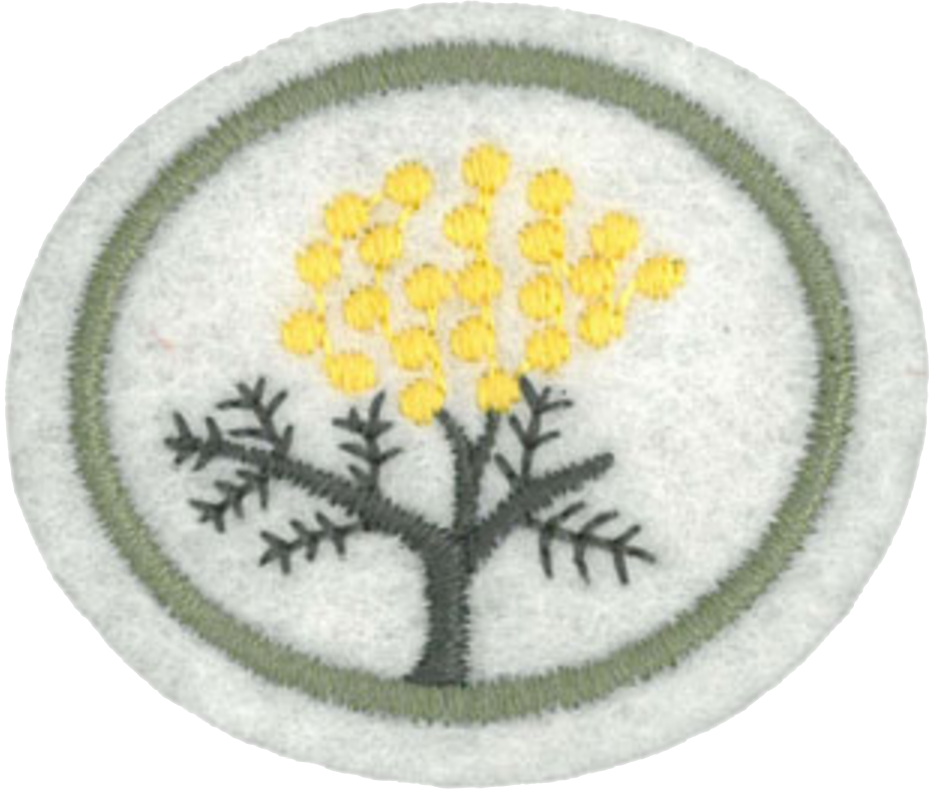Difference between revisions of "AY Honors/Wattles/Requirements"
Jomegat bot (talk | contribs) (Bot: Automated import of articles *** existing text overwritten ***) |
m (- Category of Honor Requirements) |
||
| (4 intermediate revisions by the same user not shown) | |||
| Line 1: | Line 1: | ||
{{HonorSubpage}} | {{HonorSubpage}} | ||
| − | |||
| − | |||
<section begin=Body /> | <section begin=Body /> | ||
| − | + | <b>1. <section begin=req1 /><noinclude><translate><!--T:1--> | |
| − | <b>1. <section begin=req1 /><noinclude><translate></noinclude>What is the approximate number of named varieties of wattles in Australia? | + | </noinclude>What is the approximate number of named varieties of wattles in Australia? |
<noinclude></translate></noinclude><section end=req1 /></b> | <noinclude></translate></noinclude><section end=req1 /></b> | ||
| − | <b>2. <section begin=req2 /><noinclude><translate></noinclude>a. What are phyllodes? | + | <b>2. <section begin=req2 /><noinclude><translate><!--T:2--> |
| − | :b. What work do they do for the plant? | + | </noinclude>a. What are phyllodes? |
| − | :c. Why are phyllodes so important in the study of acacias? | + | :b. What work do they do for the plant? |
| + | :c. Why are phyllodes so important in the study of acacias? | ||
<noinclude></translate></noinclude><section end=req2 /></b> | <noinclude></translate></noinclude><section end=req2 /></b> | ||
| − | <b>3. <section begin=req3 /><noinclude><translate></noinclude>How are acacias classified into two major groups? | + | <b>3. <section begin=req3 /><noinclude><translate><!--T:3--> |
| + | </noinclude>How are acacias classified into two major groups? | ||
<noinclude></translate></noinclude><section end=req3 /></b> | <noinclude></translate></noinclude><section end=req3 /></b> | ||
| − | <b>4. <section begin=req4 /><noinclude><translate></noinclude>How does the shape of the seed pod and the way the seeds lie in the pod help in identification? | + | <b>4. <section begin=req4 /><noinclude><translate><!--T:4--> |
| + | </noinclude>How does the shape of the seed pod and the way the seeds lie in the pod help in identification? | ||
<noinclude></translate></noinclude><section end=req4 /></b> | <noinclude></translate></noinclude><section end=req4 /></b> | ||
| − | <b>5. <section begin=req5 /><noinclude><translate></noinclude>How many acacias in your state have true leaves (bipinnate) when adults? | + | <b>5. <section begin=req5 /><noinclude><translate><!--T:5--> |
| + | </noinclude>How many acacias in your state have true leaves (bipinnate) when adults? | ||
<noinclude></translate></noinclude><section end=req5 /></b> | <noinclude></translate></noinclude><section end=req5 /></b> | ||
| − | <b>6. <section begin=req6 /><noinclude><translate></noinclude>a. In seeding acacias what is seen first, true leaves or phyllodes? <br>6 b. How many have true leaves? | + | <b>6. <section begin=req6 /><noinclude><translate><!--T:6--> |
| + | </noinclude>a. In seeding acacias what is seen first, true leaves or phyllodes? <br>6. b. How many have true leaves? | ||
<noinclude></translate></noinclude><section end=req6 /></b> | <noinclude></translate></noinclude><section end=req6 /></b> | ||
| − | <b>7. <section begin=req7 /><noinclude><translate></noinclude>What must happen to an acacia seed before it will germinate and grow? | + | <b>7. <section begin=req7 /><noinclude><translate><!--T:7--> |
| + | </noinclude>What must happen to an acacia seed before it will germinate and grow? | ||
<noinclude></translate></noinclude><section end=req7 /></b> | <noinclude></translate></noinclude><section end=req7 /></b> | ||
| − | <b>8. <section begin=req8 /><noinclude><translate></noinclude>What acacias phyllodes are used to feed stock in times of drought? | + | <b>8. <section begin=req8 /><noinclude><translate><!--T:8--> |
| + | </noinclude>What acacias phyllodes are used to feed stock in times of drought? | ||
<noinclude></translate></noinclude><section end=req8 /></b> | <noinclude></translate></noinclude><section end=req8 /></b> | ||
| − | <b>9. <section begin=req9 /><noinclude><translate></noinclude>What is the bark of some acacias used for in Australia? | + | <b>9. <section begin=req9 /><noinclude><translate><!--T:9--> |
| + | </noinclude>What is the bark of some acacias used for in Australia? | ||
<noinclude></translate></noinclude><section end=req9 /></b> | <noinclude></translate></noinclude><section end=req9 /></b> | ||
| − | <b>10. <section begin=req10 /><noinclude><translate></noinclude>What species of acacias are used for furniture making? | + | <b>10. <section begin=req10 /><noinclude><translate><!--T:10--> |
| + | </noinclude>What species of acacias are used for furniture making? | ||
<noinclude></translate></noinclude><section end=req10 /></b> | <noinclude></translate></noinclude><section end=req10 /></b> | ||
| − | <b>11. <section begin=req11 /><noinclude><translate></noinclude>How do acacias help and benefit man, animals, insects, birds? | + | <b>11. <section begin=req11 /><noinclude><translate><!--T:11--> |
| + | </noinclude>How do acacias help and benefit man, animals, insects, birds? | ||
<noinclude></translate></noinclude><section end=req11 /></b> | <noinclude></translate></noinclude><section end=req11 /></b> | ||
<section begin=challenge /> | <section begin=challenge /> | ||
| − | <b>12. <section begin=req12 /><noinclude><translate></noinclude>Make a collection of 10 or more dried pressed wattles with flowers and phyllodes and where possible pods and seeds. Show dates, place collected, common and scientific names. Some must be spike type flowers, some raceme type or single balls and some bipinnate leaves. <br><center>OR</center><br>20 or more close-up photographs you have taken of wattles showing the above details. | + | <b>12. <section begin=req12 /><noinclude><translate><!--T:12--> |
| + | </noinclude>Make a collection of 10 or more dried pressed wattles with flowers and phyllodes and where possible pods and seeds. Show dates, place collected, common and scientific names. Some must be spike type flowers, some raceme type or single balls and some bipinnate leaves. <br><center>OR</center><br>20 or more close-up photographs you have taken of wattles showing the above details. | ||
<noinclude></translate></noinclude><section end=req12 /></b> | <noinclude></translate></noinclude><section end=req12 /></b> | ||
<section end=challenge /> | <section end=challenge /> | ||
<section end=Body /> | <section end=Body /> | ||
| − | |||
| − | |||
| − | |||
| − | |||
| − | |||
Latest revision as of 19:26, 21 July 2022
1. What is the approximate number of named varieties of wattles in Australia?
2. a. What are phyllodes?
- b. What work do they do for the plant?
- c. Why are phyllodes so important in the study of acacias?
3. How are acacias classified into two major groups?
4. How does the shape of the seed pod and the way the seeds lie in the pod help in identification?
5. How many acacias in your state have true leaves (bipinnate) when adults?
6. a. In seeding acacias what is seen first, true leaves or phyllodes?
6. b. How many have true leaves?
7. What must happen to an acacia seed before it will germinate and grow?
8. What acacias phyllodes are used to feed stock in times of drought?
9. What is the bark of some acacias used for in Australia?
10. What species of acacias are used for furniture making?
11. How do acacias help and benefit man, animals, insects, birds?
20 or more close-up photographs you have taken of wattles showing the above details.


